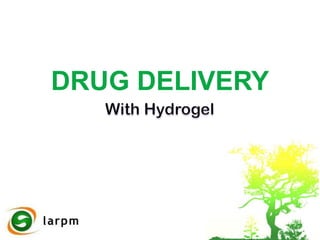Material development for drug delivery
- 2. Quick View
- 3. Hydrogel : Swellable Polymeric Materials Hydrogels are three dimensional networks of hydrophilic polymers. Extremely absorbent and possess a degree of flexibility very similar to natural tissue . Drug encapsulated in a hydrogel matrix is only released after contact with organ-or tumor-specific molecules (e.g. surface proteins).
- 4. Advantages Of Hydrogels Adaptable targeting system, allowing great flexibility for many different drugs. Offers more accurate drug placement. Creating a more precise response and fewer side effects. Non-toxic and biocompatible, raising the level of bio-safety for the patient. Absence of Phagocytosis by macrophages.
- 5. Loading and Release Mechanisms in Hydrogels In Multiphase Loading method Drugs are modified with a microparticles that are drugs are pre-loaded into subsequently entrapped in hydrogels. into crosslinkable and Drugs are loaded hydrogels via in situ cleavable linker that can be entrapment or post- liberated once the tethers fabrication equilibrium are degraded hydrolytically partitioning. or enzymatically. Therapeutics-loaded micro particle
- 6. Factors affecting the drug release from Hydrogels
- 7. Delivery of bioactive molecules in Bone and Cartilage tissue Articular cartilage Cartilage is aCartilage : Absorbing impact forces, Functions of dense and fibrous connective tissue composed of an extracellular matrix bone, and Allowing Transferring load to the underlying (ECM) that contains collagen type II,movement of the joint. low-friction proteoglycans, and water.
- 8. Material Development UHMWPE PVA - H (Ultra-high molecular weight polyethylene ) (Poly vinyl alcohol - Hydrogel) Carriers should have particular structure to facilitate cellular infiltration and growth of defected bone & cartilage tissue. Many macrophage and giant cells are surrounding the particle due tono foreign-body reactions. Almost intense foreign-body reactions.
- 9. Poly(Vinyl Alcohol) - Hydrogel Poly(vinyl alcohol) (PVA) gels have been formed through Chemical Crosslinking with aldehydes or photopolymerization. It can create harsh environments that are potentially toxic to cells.
- 10. Freeze -Thawing method Agitating under Keeping at PVA + DMSO a nitrogen air ŌłÆ20 ┬░C Solution current for 10 hrs Adding Vaccum Drying PVA Ethanol (100 ŌĆō 120 ┬░C) Drygel It gives a PVA-H with high mechanical strength, high water content, and excellent transparency.
- 11. Importance of Hydrogel Infiltration Macroscopic appearance Microradiograph appearance Histological appearance Cross-sectional
- 12. Injection Molding Method PVA At 150,160,180,200 ┬░C Melting Injection Molding DMSO/H2O Injection Pressure 120 MPa solution Injection Velocity 10 cm┬│/sec (8:2) Injection at 150,160,180,200 ┬░C PVA Hydrogel
- 13. Influence of heating temperature on Tensile Strength Degree of polymerization: 8,800 Water content: 30%
- 14. Stress ŌĆō Strain curves of various PVA - Hydrogel Samples PVA ŌĆō H water content: 20% Articular Cartilage PVA ŌĆō H W.C : 45% PVA ŌĆō H W.C : 90% Meniscus
- 15. Frictional Coefficient of Materials In Synovial fluid Synovial fluid (simulated lubricants) : Saline with 0.375% hyaluronic acid, 3.0% albumin, 0.5% ╬│-globulin.
- 16. Frictional Coefficient of Materials In Synovial fluid
- 17. Method of Drug Delivery Magnified view: Matrix-based MSC After 10 days of culture Isolated defected Macroscopic Cartilage Appearance: After treatment Bioactive factors formed by MSCs have been shown to MSCs embedded in a collagen type I hydrogel can be inhibit tissue scarring, suppress apoptosis, stimulate used for tissue engineering(MSCs) can Mesenchymal stem cells of cartilage angiogenesis, and the damaged cartilages. repair enhance mitosis of tissue-intrinsic stem or progenitor cells.
- 18. Future Developments References Using injectable hollow, biodegradable nanofiber spheres as cell carriers is likely to Suong Hyu. 1. Masanori Kobayashi and Hyon repair knee cartilage more effectively Evaluation of Polyvinyl Alcohol- Development and than current methods. Hydrogels as an Artificial Atrticular Cartilage Materials 2010, 3, 2753-2771 2. Ulrich N├Čth, Andre F Steinert and Rocky S Tuan . PVA is non-adhesive to cells and proteins, but for be Technology Insight: adult mesenchymal stem cells can covalently modified with cell attachment osteoarthritis therapy Nature Clinical Practice Rheumatology (2008) 4, 371-380 3. peptidesSayedbioactive regulation. Maha Nasr for Aly Intra-Articular Drug Delivery: A Fast Growing Approach Recent Patents on Drug Delivery & Formulation 2008, 2, 231-237
- 19. Thank youŌĆ” Thank youŌĆ” Thank youŌĆ” Thank youŌĆ” Thank youŌĆ” Thank youŌĆ” By Presented Thank youŌĆ” chem.adams@gmail.com



















